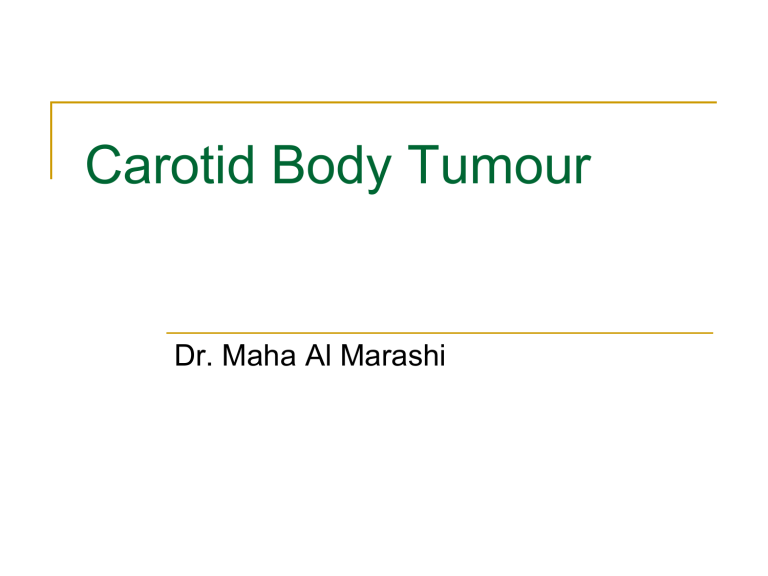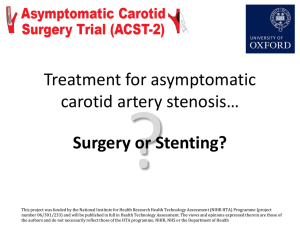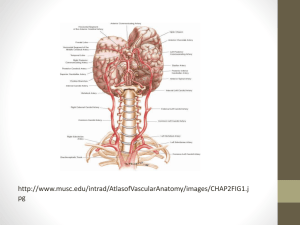Carotid Body Tumour

Carotid Body Tumour
Dr. Maha Al Marashi
KM. 34 Female
Elective admission for Right Carotid body tumour excision
Had been referred initially to the vascular service with bilateral carotid body tumours
Incidental finding with no local pressure symptoms or systemic effects
KM. 34 Female
BGHx:
Left carotid body tumour embolizaion
Appendectomy as a child
Tonsillectomy as a child
KM. 34 Female
Medications:
Nil
Allergies:
Nil
KM. 34 Female
Family Hx:
Grandfather – Carotid body tumour
Brother – Carotid body tumour bilaterally
KM. 34 Female
Ultrasound scan neck
Evidence of bilateral carotid body tumours of the carotid bifurcation consistent with carotid body tumours.
Thyroid gland is normal.
No other abnormalities.
KM. 34 Female
Duplex scan of carotids
Bilateral masses in the region of the carotid body at the bifurcation of the internal and external carotids.
Right is smaller and more vascular.
Left encases vasculature.
KM. 34 Female
Genetic screening:
KM. 34 Female
Right carotid body tumour excision
KM. 34 Female
Histology:
KM. 34 Female
Discharged home day 2 post op with no complications
Simple analgesia and aspirin
For OPD follow up in 4 weeks.
Carotid body tumours
Anatomy
Bifurcation of the common carotid artery
Right side coming of the brachiocephalic artery
Left side from arch of aorta
Anatomy
3.
4.
1.
2.
5.
6.
Thyroid gland
Trachea
Brachiocephalic artery
Common carotid artery
Internal jugular vein
Superior vena cava
Embryology
Derived from:
Mesodermal elements of the third branchial arch
Neural elements originating from the neural crest ectoderm
Neural crests differentiate into forerunners of paraganglionic cells
Paragangangliomas
Physiology
Chemoreceptors located in the bifurcation of the common carotid artery
Monitor changes in the oxygen and CO2 content and pH of the blood and rely that sensory information to the hypothalmus and brain stem to help them control cardiovascular and respiratory functions
Other cells in the carotid body respond to blood temperature and to certain chemicals, e.g., nicotine and cyanide.
Has extremely high blood flow and oxygen consumption
Histology
Resemble the normal architecture of the carotid body
Highly vascular
Zellballen (cell nests)
“Sustentacular” cell
Epithelioid cell
Cytochemical techniques have demonstrated:
Adrenaline
Noradrenaline
Serotonin
Classification
Chromaffin
Capable of producing catecholamines
Non-chromaffin
Initially, Carotid body tumours were thought to be non-chromaffin paragangliomas
≤5% of carotid body tumours are endocrinologically active
May be part of the neurocristopathies e.g. MEN 1 & 2
Secondary tumours are common, including phaeochromocytomas
Pathology
Only known pathology is neoplasia
Most common of the non-chromaffin paragangliomas
1.
2.
3.
Shamblin et al described the following anatomic groups:
Group 1: small tumours, minimally attached. Surgical excision not difficult
Group 2 : larger, moderate attachments. Can be resected, but many require temporary intra-luminal carotid shunt
Group 3 : very large, encase carotid arteries. Often require arterial resection and grafting
Incidence
Sporadic
More common
5% incidence of bilateral tumours
Familial
Autosomal dominant
32% incidence of bilateral tumours
Men:Women = 1:1
Screening of family members recommended
Age
Range between 20-80
Most apparent in 5 th decade
Biologic behaviour
Malignant potential
Cannot be predicted by histological markers
Made by presence of lymph nodes or metastases
Metastatic spread
In region of lymph nodes
Kidney, thyroid, pancreas, cerebellum, lungs, bones, brachial plexus, abdomen and breast
Rate approximately 5%
Predictors
Severity of symptoms
Size at time of diagnosis
History
Painless swelling in neck at the angle of the mandible
Non-specific
Neck or ear pain
Local tenderness
Hoarseness
Dysphagia
Tinnitus
Occasionally
Cranial nerve dysfunction
Rarely
Lateralizing central neurological signs or symptoms
Neurosecretory
Dizziness
Flushing
Palpitations
Tachycardia and arrhythmias
Headache and photophobia
Diaphoresis
Examination
Neck mass below the angle of the mandible
Laterally mobile but vertically fixed
Non-tender, rubbery, firm and non-compressible
Often pulsatile
Bruit
Abnormalities caused by vagal or hypoglossal nerve impingement
Horner’s syndrome (rare)
Palpate opposite side
Differential diagnosis
Lymphoma
Metastatic tumours
Carotid artery aneurysm
Thyroid lesions
Submandibular salivary gland tumours
Branchial cleft cysts
Investigations
Duplex scan with colour flow imaging
Documents the highly vascularised mass in the area of carotid bifurcation
Tumour dimensions
Co-existent carotid occlusive disease
Angiography
Gold standard
Identifies collaterals, concurrent atherosclerosis and multicentric disease
Dynamic or rapid sequencing CT
Differentiates between aneurysm and neoplasm
Size and extent
MRI
Demonstrates relationship of tumour to adjacent structures
Differentiate from other soft tissue lesions at base of skull
Size and extent
Management
Mainstay is complete surgical excision due to:
≥5% incidence of metastases
Unrelenting growth of unresected tumours
Early excision decreases incidence of cranial nerve and carotid artery damage
Most are in Shamblin’s group 2 or 3 at time of clinical presentation
Radiation for local control of residual or recurrent disease
Chemotherapy has no role
Pre-operative embolization
Pros: Decrease vascularity and improve safety
Cons: thrombosis of ICA or cerebral embolization
Prognosis
Carotid body tumours are slow growing and exhibit benign characteristics
Can survive for long periods without surgical intervention
Death due to asphyxia and intra-cranial extension; Martin et al noticed death rate of approximately 8% in untreated patients
Even after prolonged disease-free intervals, local recurrence following surgical resection described









